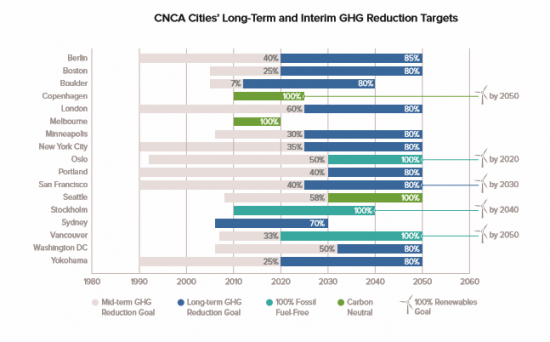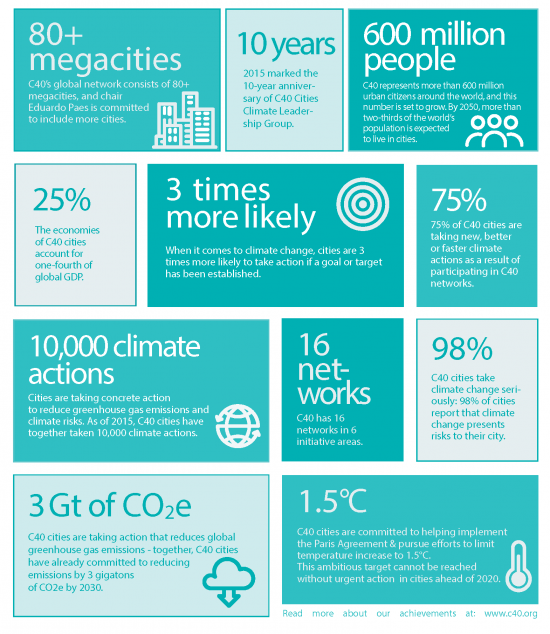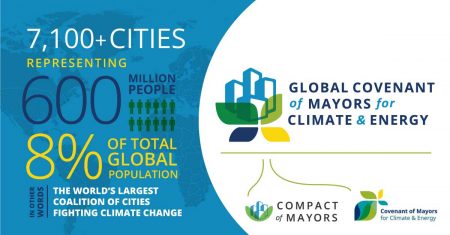November 24, 2016 – In a Time Magazine headline last week Johanna Partin wrote that America’s cities are the only hope for climate change action in light of the election of Donald Trump. She argued that Trump’s announced plans to increase fossil fuel extraction and burning, both coal and natural gas, “will lock-in unsustainable carbon emissions for decades to come.” Expanded production of shale oil and gas, coal, and likely conventional oil from offshore sites, combined with pipeline expansion will be among the incoming President’s top priorities.
She went on to state that because cities produce nearly 75% of all the greenhouse gas emissions we humans are responsible for, it will be urban centres where decarbonization leadership will come. That’s not to say that states cannot play a part. For example, consider California’s most recent actions to reduce the state’s carbon footprint. But it is in cities where the world is seeing a commitment to fight climate change with serious intent based on the findings of the IPCC and the Paris global agreement. Three alliances of cities focused on decarbonization include the Carbon Neutral Cities Alliance (CNCA), C40 Cities Climate Leadership Group, and the Covenant of Mayors.
Carbon Neutral Cities Alliance (CNCA)
Seventeen cities from Europe, the United States, Canada, Japan and Australia have formed CNCA to focus on emission reductions and a transition to a carbon neutral and sustainable future. They have set a decarbonization goal of 80 to 100% reductions by 2050 which they have named the “80×50.”
In a 134-page document they outline their framework for long-term deep carbon reduction planning that includes:
- Developing Carbon Neutrality Planning Standards — Developing approaches, analysis, and tools to support carbon neutrality; standardizing measurement and verification methodologies for tracking progress.
- Advancing “Transformative Change” in Key Urban Sectors — Sharing and implementing best practices for achieving transformative deep carbon reduction strategies in urban transportation, energy use, and waste systems.
- Advocating for Policy Change — Identifying and advocating for policies at the state, regional, and federal levels to reduce emission sources not controlled directly by cities and engaging with other external stakeholders who are critical to cities’ success.
- Speaking with a Common Voice — Helping CNCA cities demonstrate their leadership and communicate with a common voice.
- Creating a CNCA “Innovation Fund” — Investing in high-potential, city-led projects that develop, test, implement, and amplify deep decarbonization strategies and practices. The latest awards round announced the funding of eight new projects this month to the tune of almost $880,000 U.S.
- Increasing Alliance Impact — Sharing Alliance learning with a broader audience to benefit the “next wave” of cities striving for carbon neutrality.
Each city in the alliance has set an individual target but all are committed to the “80×50.” The infographic below lists the cities and their individual greenhouse gas (GHG) emission timetables for target reductions.
A sample of how some of these cities are doing so far.
- Since 1990 Berlin has reduced GHG emissions by 29% while growing the GDP by 19% and population by 1%.
- Copenhagen since 2005 has reduced GHG emissions by 31%, grown the local economy by 18% and population by 15%.
- Portland since 1990 has decreased GHG emissions by 14%, increased population by 31% and jobs by 20%.
- Sydney from 2006 to 2012 decreased GHG emissions by 12% while population increased 4% and the local economy grew by 3%.
- And Washington, DC, has reduced GHG emissions since 2006 by 16%, per capita emissions by 24%, increased population by 11%, employment by 8% and GDP by 9%.
C40 Cities
Started in 2005, C40 includes 86 affiliated cities representing 25% of global GDP and 1 in 12 people worldwide. The focus of the group is addressing climate change. The group has committed to reducing GHG emissions by 3 gigatons by 2030. The infographic describes the mission and action plan of C40.
The founding of C40 was based on the idea that cities can achieve more working together. Beginning with 18 cities it has now grown to 86 representing over 600 million people. The 3 gigatons CO2 emission reduction target by 2030 is equivalent to taking 600 million vehicles off urban roads. States Anne Hidalgo, Mayor of Paris and recent host to the COP21 2015 Climate Change summit, “As mayors, we all face similar challenges and have to innovate to solve them, often in the same ways. The C40 network connects us all, enabling us to share ideas and collaborate, working together towards a greener, healthier future.”
C40 works with the Global Covenant of Mayors (CoM) for Climate and Energy, the third in this triad of urban organizations fighting climate change.
Covenant of Mayors (CoM)
Launched in 2008 by the European Commission with a focus on sustainable energy and climate policies, today the CoM although still European focused, has formed a super group embracing 7,100 urban centres in 119 countries and six continents, and representing more than 600 million people.
Prior to the Paris COP21 meeting the CoM announced a three pillar strategy that included:
- Mitigation – a 27% CO2 reduction target by 2020 based on baseline levels from 1990, and a 40% reduction by 2030
- Adaptation – committing to action to adapt to climate change
- Secure, sustainable and affordable energy – improving energy efficiency in existing infrastructure and expanding renewable energy sources
In its latest report from 315 members covering 25.5 million people overall GHG reductions have reached 23% putting those reporting well ahead of target to hit 27% or better in the next three years.
Breaking it down further the reductions so far are as follows:
- GHG emissions from electricity consumption decreased by 17 % from baseline through the use of less-carbon-intensive fuels and more efficient electricity generation.
- GHG emissions in buildings from heating and cooling fell by 36 % from baseline driven by improved energy efficiency, lower energy consumption levels, more efficient local heat production from district heating networks, and increasing renewable resources in decentralized local heating
- GHG emissions in transportation fell by 7 % from baseline driven by more efficient vehicles, an increased use of biofuels, a shift towards public transportation and increased electric mobility.
The CoM, unlike CNCA and C40 includes a significant number of small and medium-sized towns and cities. In fact 89% of members are from smaller centres who believe that their cumulative role in reducing GHG emissions can play as significant a part as their larger urban cousins in meeting the objectives laid out in the Paris Climate Agreement.
States Martin Schulz, President of the European Parliament, “Cities and city-led initiatives like the Compact of Mayors and the Covenant of Mayors are key forces to make the Paris Agreement a success…..further proof that cities are heeding the call by the world’s urban leadership to innovate faster, reduce climate emissions and enhance resilience to meet the Paris climate goals. This initiative shows the force of a bottom-up approach, of local ownership and of voluntary – but real – commitments.”



















[…] As we can’t rely on government, cities and businesses are increasingly taking more of a leadership role on climate change and circular economy. This trend is happening internationally as well. […]